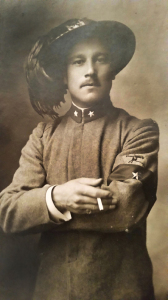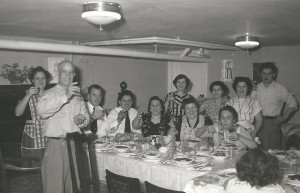It is the 11th of November, which is both Veterans Day and Martinmas. This particular melding of the federal holiday calendar with the traditional seasonal round of the year fascinates me. Veterans Day is the day we honor those who have served in the armed forces… but so many have lost their lives doing so, it by nature becomes a day of remembering the dead (even though Memorial Day in May is set aside especially for this purpose). Veterans Day began as Armistice Day, marking the end of World War I, or the Great War, as it was known earlier on. The armistice ending the war was signed earlier in the morning on November 11, 1918, but the cease fire took effect on the 11th hour of this 11th day of the 11th month.
Did they know, when that document was being signed on the 11th of November, 1918, that it was Martinmas? Sure they did; folks back then were much more attuned to the seasonal round and traditional ways. Did they understand the significance that Martinmas concludes our traditional time of remembering the dead, a time that began with All Hallows’ Eve and progressed through All Saints Day and All Souls Day? I don’t know, but I imagine they did. So many people lost their lives in that “war to end all wars,” and it would be right to honor them at Martinmas.
Another name for Martinmas is Hollantide. This has nothing to do with Holland, but it does have a lot to do with Halloween. Hollantide is a corruption of “Hallowtide.” These days and words are all related: the older name for All Saints Day on the First of November is All Hallows’ Day. Halloween, on October 31, is All Hallows’ Eve (written, earlier on––and not all that long ago––as Hallowe’en, with an apostrophe taking the place of the V in “Eve”). These eleven days since Halloween are the time (the “tide”) of All Hallows, when we remember our dead, when we retreat inward, just as the trees around us lose their leaves and focus their growth now below ground, building a strong root system to carry through the winter ahead and to usher forth new growth come spring. The dead and the roots share that same earth. It and we are one and the same. From that same earth grow the poppies in Flanders fields.
Martinmas itself is the feast day of St. Martin of Tours. He, too, was a veteran, of the Roman army. He converted to Christianity and became a pacifist and is known for his charitable works. Well, one in particular: on a cold winter’s night, Martin came across a poor, drunken man shivering in the cold. So he tore his own cloak in two, giving half to the drunken man for warmth. St. Martin is now a patron saint of tailors and winemakers… and of those who have had a little too much to drink. (Remember him during your next hangover.)
His day has become deeply associated with wine. Martinmas is the day to have a taste of the new wine, by now just a few weeks old. It is the day, traditionally, that the young Beaujolais wines of France are released. It is also the last big religious feast before advent, which used to be a time of fasting… and so Martinmas was also an excuse for a big meal, usually goose or turkey. And, since it is autumn, chestnuts, and in Italy, where these autumnal days of remembering the dead are known as I Morti, special biscotti that are baked not twice but thrice. Biscotti di San Martino are so hard and tough, you really can’t eat them without dunking them in wine first.
And so it is Martinmas, Hollantide, Veterans Day. I think of old family photos on this day, black and white photos, filled with aunts and uncles raising glasses toward the camera. I think of Wilfred Owen, the English poet who died in combat in France just a week before the Great War ended. His mother received the news of her son’s death on Armistice Day, while the village church bells rang in celebration. I think of my grandfather, Arturo. I grew up with him always nearby. He taught me how to hold a pool cue and how to play Eight Ball and Solids & Stripes, and we would play old Italian card games on 40-card Italian decks with bizarre pictures on them, games like Scopa and Briscola. He would pat my head and speak to me in Italian and I would answer in English and on the wall in one room of the house was the photograph you see above, a photo I used last year in this blog, but it’s so good it deserves a second printing. There he is: Arturo, my grandpa, a version of him I knew only as a photograph: a soldier in the Italian army, during the Great War. He was one of the Bersaglieri, an elite quick moving infantry unit in distinctive plumed caps. Even today, the Bersaglieri do not march; they trot. (That video, too, is worth a reprint from last year.)
And so on this day we remember the veterans, we remember the dead, we remember the people toasting the camera. We honor them all, the winemakers, the drunkards, St. Martin himself. Our days remembering the dead conclude now as autumn progresses. Soon will come advent, soon will come winter, soon will come the longest night… and eventually the poppies in Flanders field will bloom again.

